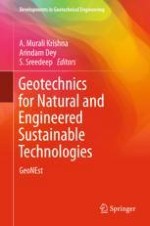
2018 | OriginalPaper | Chapter
Addressing Sustainable Technologies in Geotechnical and Geoenvironmental Engineering
Authors : Krishna R. Reddy, Girish Kumar
Published in: Geotechnics for Natural and Engineered Sustainable Technologies
Publisher: Springer Singapore
Activate our intelligent search to find suitable subject content or patents.
Select sections of text to find matching patents with Artificial Intelligence. powered by
Select sections of text to find additional relevant content using AI-assisted search. powered by